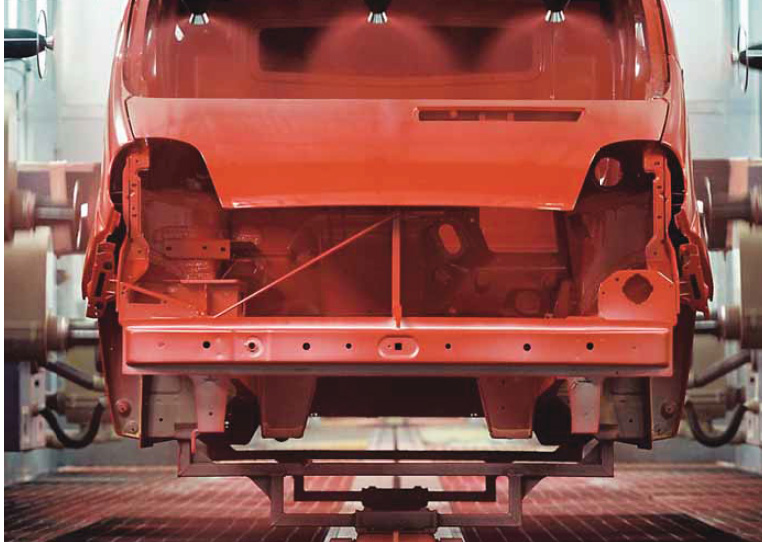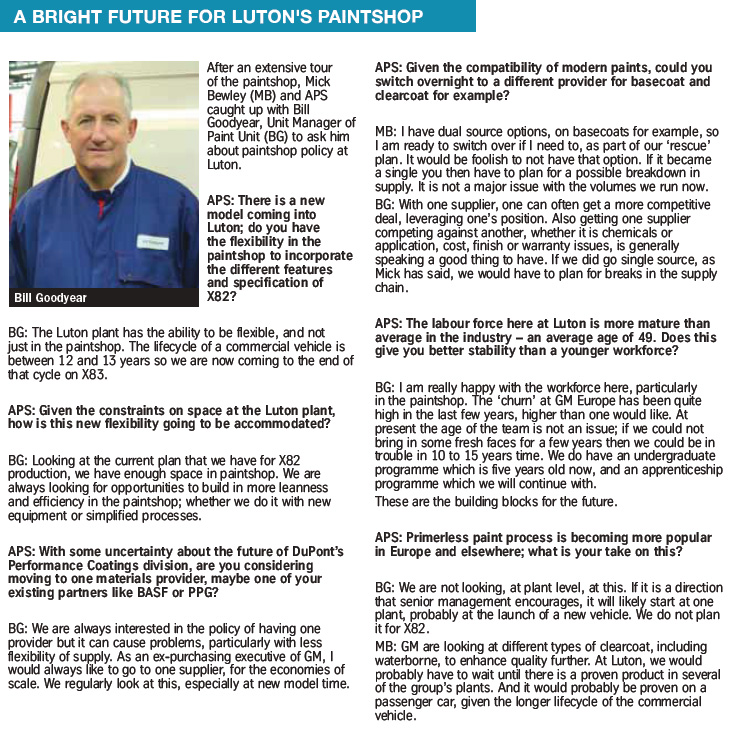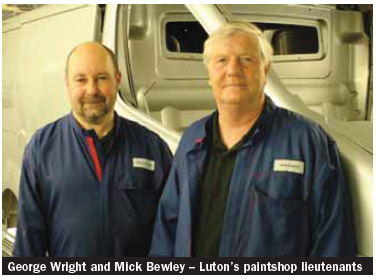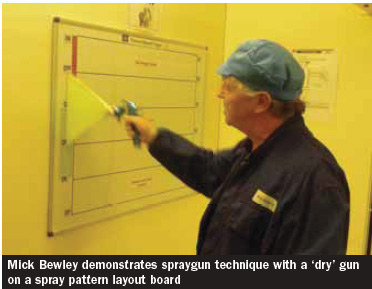
The Vauxhall Van Plant in Luton, some 50 kilometres north of London is home to production of the Vauxhall Vivaro, Nissan Primastar and Renault Trafic vans. The present model is codenamed X83 and a new van, X82, will start production in January 2014. The vans differ only in badges and some minor specifications and options. One particular feature they share fully is a car-like paint finish.
As Mick Bewley, Paint Process and Quality Manager explains: “Every van coming out of the plant has a premium car finish, combined with the durability of a commercial vehicle paint process.” The plant stamps and welds together all the panels and the finished body-in-white runs through the Dürr electro coat paint operation (ELPO) on c-carriers. They are then transferred to ‘paint spines’ which belong to the paintshop, and each of these carries a barcode.
 This is particularly important as there are 110 different body configurations and, while there are just 12 main paint line colours, there is a custom palette of 125 SVO (special vehicle operations) colours. In addition, many companies have their own brand colour which may be specified as Bewley says: “We can do any colour within 12 weeks; in any quantity, from a fleet of vans down to a single vehicle.”
This is particularly important as there are 110 different body configurations and, while there are just 12 main paint line colours, there is a custom palette of 125 SVO (special vehicle operations) colours. In addition, many companies have their own brand colour which may be specified as Bewley says: “We can do any colour within 12 weeks; in any quantity, from a fleet of vans down to a single vehicle.”
Sealing and insulation – freehand and automated. In a reversal of what might be expected, all interior sealing is performed by four KUKA robots, working through the closed front doors’ windows and open rear ‘barn’ doors, and some exterior sealing is applied by skilled operators working ‘freehand’.
The most difficult seam is the vertical joint of the two side panels, which is covered in one smooth stroke. The same operator ‘tidies’ the roof ditch seam, which has been sealed by robot. Underbody sealant is applied by four KUKA robots, apart from the inside of the sills (rocker panels) which must be carried out by hand as Bewley explains: “I can’t get a robot set up to apply sealer on the inside of the sill lip without getting it on the outside, where I don’t want it.” Sealant comes from EFTEC and has a pvc composition that requires oven curing. A Dalmec lifter is used to ‘stick up’ an insulation pad inside the cab roof – one of only two insulation pads in the whole vehicle. Primer preparation is minimal says Bewley: “The only area of significant scuffing required is on the bonnet; we are getting a run of the powder chemical used prior to the phosphate coat, we can just feel it through the ELPO layer so it has to be rubbed down.”
Primer and basecoat – premium process
The ELPO is, however, good enough to be the foundation for the basecoat inside the van; the only vehicles that have any interior primer are those to be painted SVO yellow; these have the door shuts primed by hand at the end of the primer line. A water-borne primer is used on the exterior; StarBloc from BASF. This is applied by Dürr Ecobell with a 45,000 rpm spin at 80KV.
Basecoat is applied by robot, including rear interiors (cargo areas) but excepting the door shuts, underbonnet and engine bay, these are painted by hand. Solid colours are alkyd melamines from BASF, metallics come from DuPont. 43% of the total build is specified white. The clearcoat is an alkyd melamine; 3.5 litres of which is applied by robot all over the vehicle and in the cargo area as per the basecoat coverage, apart from the door interiors, these are painted manually. As the van body has so many variants, the paintshop has to be particularly flexible. For example, on bodies to be used as minibuses, the ledges used as armrests are clearcoated by robot.
Vans obviously require more paint to cover the bodies but the greater amount of surface area compared to a passenger  car is still quite surprising, as Mick Bewley relates: “The van body is 52 square metres, a Vauxhall Corsa is only 16 square metres. Yet we are certainly not given three times the budget to get a similar quality finish!” Polishing is carried out using the 3M Trizact system; the total build is no more than 110 microns and as the solid colours have no clearcoat, there is little room for error.
car is still quite surprising, as Mick Bewley relates: “The van body is 52 square metres, a Vauxhall Corsa is only 16 square metres. Yet we are certainly not given three times the budget to get a similar quality finish!” Polishing is carried out using the 3M Trizact system; the total build is no more than 110 microns and as the solid colours have no clearcoat, there is little room for error.
Energy saving and environmental concerns
Most of the ovens are fairly old, installed by Haden Drysys 22 years ago but some are more modern, from George Koch Sons Europe, and are linked to the air replacement plant (ARP) energy saving system installed by DACS. This uses Eurotherm controllers and is basically an upgrade of the original ARP system. The system controls the temperature and humidity of the ovens as one, making constant adjustments, as fine as +/- 2%, translating to 0.50°C
It works by using more sensors than installed in the past, and sophisticated software to constantly monitor and adjust the burners with more finely modulated controls than previously. Manufacturing engineer George Wright is very proud of the cost savings and energy conservation that the system has enabled: “We save €450,000 per year over the previous energy bills and we get the heat we need at the right time with much less waste, which is good for the environment as well.” The paintshop uses a wet scrubber system that, while not being the very latest technology, is managed carefully to save water. The water is changed just three times per year and the plant has its own artesian well, bringing the total site water bill down to 45,000 per year.
 Learning in Luton – Vauxhall’s undergraduate scheme
Learning in Luton – Vauxhall’s undergraduate scheme
As Bill Goodyear says in his interview, the undergraduate scheme at Luton is highly successful and attracts some fine young engineers who can gain a lot from the experience and also contribute a great deal. This scheme is particularly important to the plant as the present average age of the workforce is 49; so new blood is seen as essential to keep the plant fresh and efficient over the production cycle of the X82 vehicle programme.
Undergraduates are recruited to the manufacturing engineering group, which is responsible for the equipment, tooling and product changes within the Luton Plant, and is situated within either body, paint, general assembly or quality operations.
The key responsibilities of an undergraduate would include working on different plant based projects and initiatives. In  each of these projects the person would be responsible for the development, planning, coordination, and implementation phases, under the guidance of an experienced engineer. There is a particular emphasis on the candidates using their manufacturing knowledge (gained in their studies and also learnt at the plant) to assist in resolving capacity, design, manufacturing and quality issues. Specific tasks would include the validation and testing of facilities and manufacturing processes, managing the introduction of product changes and new features on vehicles.
each of these projects the person would be responsible for the development, planning, coordination, and implementation phases, under the guidance of an experienced engineer. There is a particular emphasis on the candidates using their manufacturing knowledge (gained in their studies and also learnt at the plant) to assist in resolving capacity, design, manufacturing and quality issues. Specific tasks would include the validation and testing of facilities and manufacturing processes, managing the introduction of product changes and new features on vehicles.
Gaining with the group
The placement scheme includes liaison with other engineering centres, Vauxhall Engineering Centre (VEC), & GME Manufacturing Engineering Group and technical liaison with suppliers. One of the key features of the scheme is that it gives each engineer the opportunity to see how paintshop ‘meshes’ with other parts of the manufacturing process. The engineers run through programmes such as understanding how to ensure that products meet marketing and quality requirements and that both the product and the plant meet current and future legal requirements. Engineering release of key concepts and features is also covered; this is particularly interesting and important during the next 12 months, with the changeover to the new X82 vehicle programme.
One of the most important studies for future paintshop engineers is line balancing; the speed (or some might say the lack of speed) of the paintshop can dictate the line balance in other areas, so an understanding of the total plant dynamic is very important.
 Mick Bewley’s manual spraying masterclasses
Mick Bewley’s manual spraying masterclasses
Mick Bewley, Paint Process and Quality Manager at the plant, has his own sprayers training room where he teaches the art of manual spray painting. This is particularly important on the vans made at the Luton facility as some of the most user-visible sections of the van are painted by hand.
Bewley starts his lessons with Stage 1, which begins with ‘What is paint?’ and tells us that he is often surprised by how little experienced painters know about the product they are handling: vehicles (the liquid portion of the paint that ‘carries’ the pigment), pigments, extenders, binders, additives and solvents/diluents. Stage 1 continues with a look at how manual spray affects the whole performance of the coatings, how defects are created, and the different methods for solids and basecoat applications.
In Stage 2, he takes students through spray guns and their working parts, set-up, gun and air line handling – ‘Don’t  strangle the gun’ – and posture, movement and tempo. Indeed, Bewley’s mantra is that spraying is about tempo not speed and to help students get the correct tempo and help with the rhythm, he plays the Elizabethan Symphony by William Alwyn to them as they practice, he says this is just the right tempo for spraying!
strangle the gun’ – and posture, movement and tempo. Indeed, Bewley’s mantra is that spraying is about tempo not speed and to help students get the correct tempo and help with the rhythm, he plays the Elizabethan Symphony by William Alwyn to them as they practice, he says this is just the right tempo for spraying!
The music helps students to appreciate the importance of a steady tempo, to move at not too great a speed and to achieve an economy of movement. He says he has seen some students use 180 movements to spray a door inner but looks for a lot less: “Anything over 80 movements and I expect them to be able to fly!”
One might expect spray equipment makers to offer this type of training but Bewley says not: “There is nowhere else that has this type of training available, the spraygun manufacturers used to offer some basic courses but not any more. And their tuition was not as comprehensive as what I try to offer.” Bewley has become an international trainer within GM, teaching sprayers in many GM plants including Rüsselsheim, Eisenach, Bochum and St Petersburg.




































